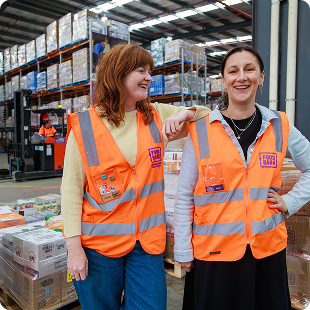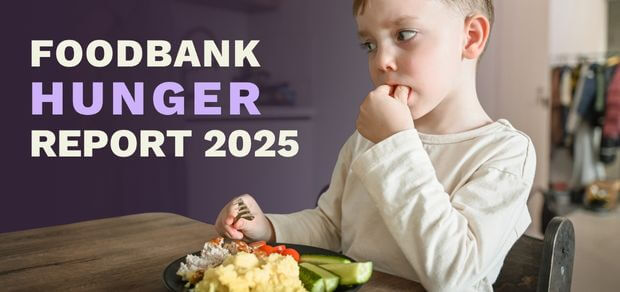Helping Victorians since 1930
Our work in Victoria dates all the way back to 1930, with the establishment of the State Relief Committee in response to the distress caused by the Great Depression. Today, our work continues – supporting Victorians with food relief in times of distress caused by financial hardship and through disasters such as bushfires, floods and drought.
In 2025, we are marking our 95th anniversary. It’s a bittersweet moment – evidence that the scale of the hunger problem and need for food relief persists to this day.
Take a look at our work across the decades
The State Relief Committee began as an initiative of the State Government of the day.
A group of eminent persons were called together by the Hon. EL Kiernan, MLC at Parliament house on 31st July 1930. They were asked to organise a state-wide appeal for goods and to coordinate the distribution to people in need during the Great Depression. Mr Harold Clapp, Chairman of the Victorian Railways Commissioners, was nominated as the Chair.
The community assisted in raising cash donations through such activities as concert parties, a VFL football variety show at the Melbourne Town Hall, moonlight excursions on the Bay and community singing. In the winter months of 1934 a Blanket Appeal was commenced in partnership with the Herald and Weekly Times. The 1937 blanket appeal raised 1200 pounds to purchase 4028 blankets.
A “Jam factory” was established and 20 unemployed women were hired to make jam from donated fruit. The 1939 annual report showed that 560,583 jars had been processed up to that time.
Following the end of the Great Depression, the State Relief Committee sought resolution as to its future.
Legislation was introduced into Parliament in 1940 which firmly authorised the continuance of the Committee’s work.
Organisers employed by the Committee visited country areas where donations of “5 shillings and promises of 19 sheep and 14 bags of wheat” were willingly arranged. Social auxiliary groups were established in country towns, the first at Macarthur in appreciation of the Committee’s assistance during bushfires in the area. The groups held balls and social functions to raise money.
Goods collected were distributed at local level through Public Assistance Committees, set up by local government, Ladies’ Benevolent Societies and other organisations registered with the Charities Boards of Victoria. Every effort was made to avoid overlapping by duplicating relief. Money was not given to applicants, the assistance was always in goods and/or food.
Individual efforts by community members were recorded in the minutes of meetings.
In 1953, First Constable G Hookey of Castlemaine was commended for his regular efforts to gather groups “to scour the orchards and despatch hundreds of cases of apples to the Committee.”
Through a Christmas effort commenced by the Herald and Weekly Times in 1954, vouchers were distributed to lonely pensioners while the Truth Toy Fund raised money to distribute toys to children. Boxes were placed at certain railway stations so that people could donate parcels of suitable clothing or household goods.
Disaster relief for victims of flood and fires was a continuing aspect of the work done by the Committee. Each Annual Report gave details of the help provided across Victoria.
The Chair, Mr Albert Monk, sought assistance from the Minister of the Labour and Industry Department in 1958 about the “meagreness of the sum provided by Treasury.” This was raised from £15,000 to £22,000 by the end of the decade.
Following severe bushfires in 1962, the Government directed that a State Disaster Plan should be developed.
The centre of operations was located at Police Headquarters in Russell Street, Melbourne within the precincts of D24 Radio Station. The Welfare Division was coordinated by the Committee together with other groups such as the Red Cross, Salvation Army and the Country Women’s Association.
A competition to “Give a Title” to a specially built home in Carrington Park Estate at Scoresby was organised for the Committee in 1960/61 and 151,449 tickets were sold.
Appeals for furniture and household goods were made regularly in country regions as well as the continued appeals in suburban areas.
In 1969 the stocks held were moved from the King Street location to new premises in Montague Street, South Melbourne. Concern about the quality of stock held over long periods led to the establishment of a sub-committee to direct and advise the reduction of holdings.
Trained social workers began being appointed into the community to provide more professional welfare assistance to those in need.
While the Committee first expressed concern over the changing focus towards counselling and referral, rather than emergency relief as the first step, by the end of the decade there were fewer applications through local police and more and more through social workers. There were also more providers of emergency relief being established in the community.
Dame Phyllis Frost, who had joined the Committee in the mid 1960s was appointed Chair in 1975. She organised a seminar in 1976 and invited the Premier, Hon. RJ Hamer, to give the opening address. It was attended by 200 people, many coming from the auxiliary groups in country areas.
The Committee continued to offer furniture as part of material aid resources and retired tradesmen assisted in repairing goods donated and collected by warehouse staff.
The annual reports of the Committee noted the increasing demand for assistance from such groups as deserted wives, migrants, Aboriginal people, aged and unemployed. In 1978 the organisation moved to premises in Jeffcott Street, West Melbourne.
During the severe Ash Wednesday bushfires in 1983 the Committee gained extensive support and recognition for the way in which assistance was sourced and distributed.
The Committee was able to solicit and receipt monetary donations as well as goods. Dame Phyllis Frost was the figurehead of the relief effort and gave tirelessly of her time and energy. Following the experiences of these bushfires, the State Disaster Plan was reviewed.
In 1986, the Act was changed and the name changed from State Relief Committee to the Victorian Relief Committee with increased powers. Many complimentary remarks were made in parliament about the work achieved by the organisation.
Up until this time the Committee had regularly received money from the Poor Box Funds but these were withdrawn in 1986 and became the Court Fund. At the same time the Committee noted that there were fewer donations from local government offices and sought to raise this matter with individual Councils and Shires.
The Committee faced a 38% reduction in funding in 1993 as the new State Government placed severe financial constraints across all government departments.
The decision was made to reduce the hours when the warehouse was open for a period. The Premier, Hon. Jeff Kennett, acknowledged the efforts made by the Committee in his foreword to the Annual Report.
Support of the Blanket and Christmas Toy Appeals continued through the fund raising efforts of the Committee. In 1995, Channel 9 provided publicity and promotion when Dame Phyllis Frost reported that the Committee was in danger of not being able to meet commitments for assistance. $250,000 worth of goods and donations were received.
Many businesses became long term suppliers. These included Uncle Tobys and the SPC-sponsored annual Share-a-Can days commencing in 1997.
After four decades of involvement, Dame Phyllis Frost retired as Chair in 2000. She remained Patron until her death, aged 87, in 2004.
Following government reviews of the work of the Victorian Relief Committee, new Chair Shirley Martin PSM, and CEO Hilary Bolton were appointed in 2001. The Committee chose to consult with representatives of government, business and the emergency relief sector to better determine the future.
With renewed vigour the committee then sought to develop partnerships and in 2003 the Salvation Army and Victorian Relief launched a joint Foodbank operation. A partnership was also established with Reverse Logistics and Coles Supermarkets Victoria to reclaim food products for distribution.
The demand for emergency relief saw a marked increase in the number of agencies working with Victorian Relief.
In 2006 the Victorian Relief Committee and Foodbank merged to become VicRelief Foodbank.
Following the tragedy of the Black Saturday bushfires in February 2009, VicRelief Foodbank played an integral role delivering food and material aid into affected communities. In the wake of the fires, the KickStart program commenced in affected areas to provide breakfast into schools. This eventually led to the establishment of the current statewide School Breakfast Clubs program, which is supporting students in 500 of the most disadvantaged state primary schools.
The 2010s has been a time of growth for Foodbank. Unfortunately, hunger continues to be a hidden but widespread issue across Australia.
In 2011, VicRelief Foodbank formally changed its name to Foodbank Victoria and continues to operate as such, part of the wider Foodbank federation operating nationally.
In 2013, there was a change in leadership with Dave McNamara appointed CEO after five years as Operations Manager.
A new visual identity for Foodbank nationally was introduced in 2014. This marked the start of a national approach to branding and an opportunity to increase awareness of Foodbank and advocacy around the the issue of hunger in Australia.
In 2015, Foodbank Victoria succeeded in securing State Government funding to implement the largest School Breakfast Clubs program in Australia.
After nine years as Chair, Alan Williams retired in 2015, with Board Director Dorothy Coombe taking over the role.
Now approaching the 90th anniversary as Victoria’s largest provider of emergency relief, Dave and Dorothy continue in their roles.
We open our warehouse for contactless drive-throughs for both food delivery and then collection during bushfires and COVID lockdowns during 2020-22. We launch the Community Bus Program and a pop-up supermarket for international students.
In 2022 Stephen Audsley becomes Chair. We respond to regional floods and begin building our Community Food Centres. The final Hunger Ride takes place.
We open our Ballarat and Morwell Community Food Centres in 2023. The Community Supermarket pilot begins. Food Fight, our school fundraising program, launches.
In 2024 the School Breakfast Clubs Program expands to all Victorian State Schools, reaching 50 million meals served. We receive Federal funding for community cooking classes in Morwell and launch the Morwell Community Supermarket. Fruit Loop fundraiser begins.
 Log in
Log in
